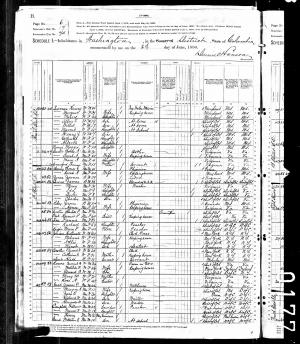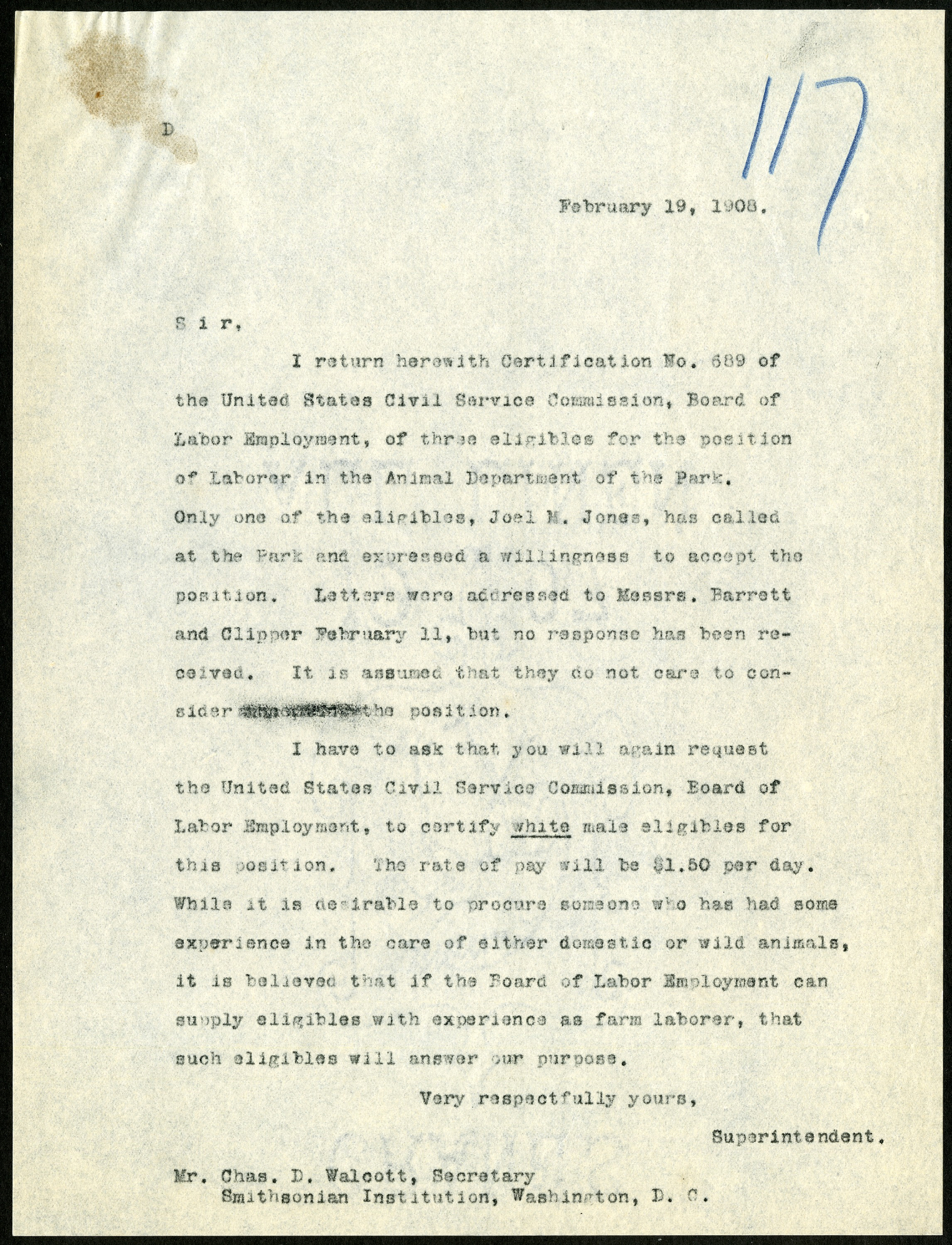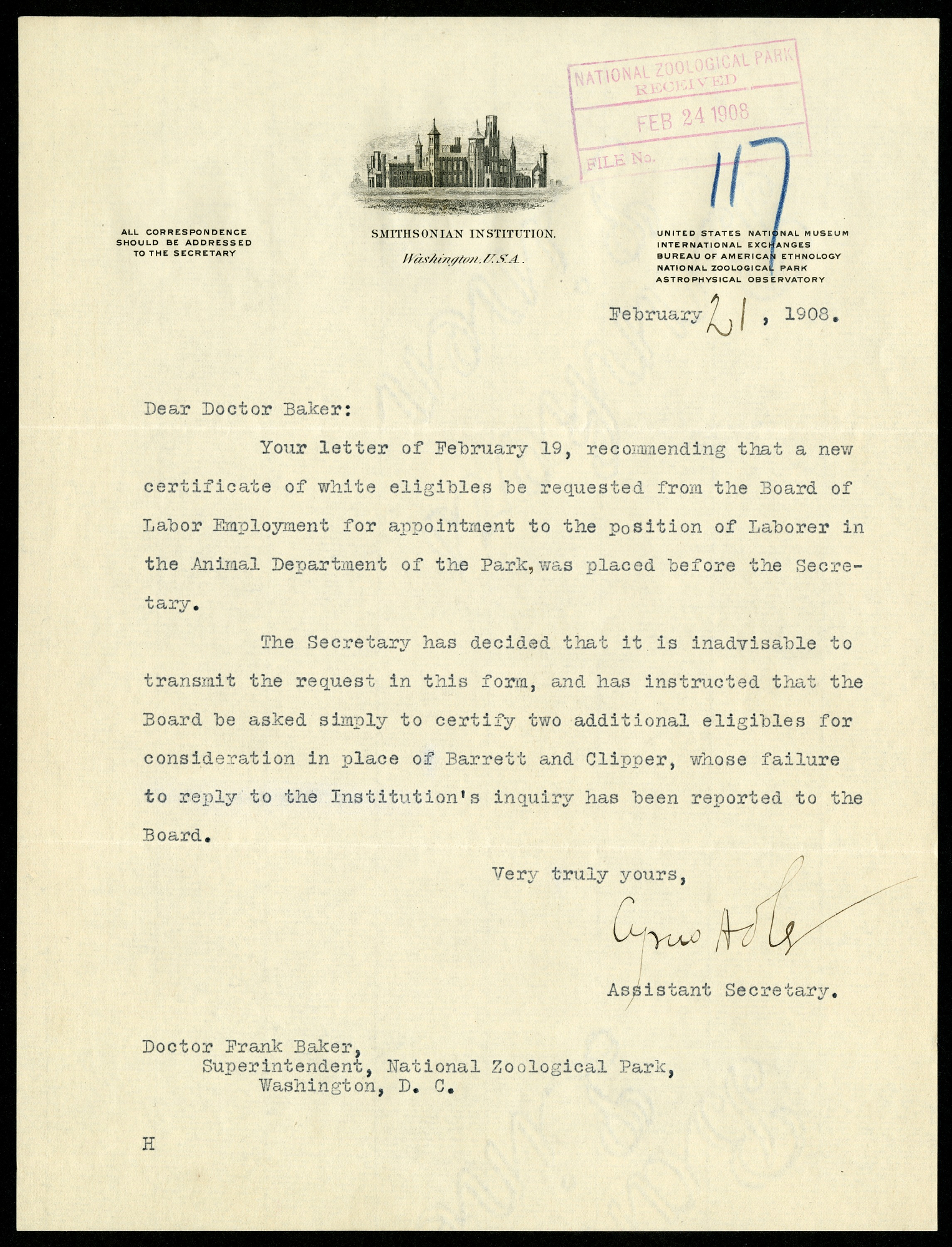James Thomas Gant

A Federal Career
As a young man, James Gant moved to the District of Columbia to make his fortune. This had to have been before city authorities passed an 1835 law that sought to restrict free black migration to the city by requiring “Negro new comers to the city enter into bond with five freehold sureties in the penalty sum of one thousand dollars for their good behavior and self-support.”2 Shortly after arriving, Gant found employment as a cook working at the Navy Yard, where he soon earned a reputation that put him in charge of setting up “big dinners” for prominent Washingtonians. On several occasions he even made meals for events at the White House.3 Despite his culinary reputation, Gant sought a more challenging career, and sometime around 1850, Gant had secured employment at the U.S. Patent Office. It was there that he met the eccentric John Varden, whose work for the National Institute for the Promotion of Science required him to collect materials deposited at the Patent Office. Little survives in the historical record about the relationship between the two men. However, in 1858, when the Smithsonian absorbed the collections of the National Institute, Varden found himself working for the newly established institution. With a letter of recommendation from Varden, Gant soon followed.4
Working in Joseph Henry’s Smithsonian
For his first two decades at the Smithsonian, Gant worked as a laborer earning $20 per month. From 4 a.m. to nightfall, he was responsible for a wide array of custodial duties ranging from sweeping the museum, dusting display cases, scrubbing floors, cleaning spittoons, and keeping the restrooms stocked and clean.5 Like many of the other black laborers, he also augmented his salary by running errands for the scientists who lived and worked in the Smithsonian. This included fetching soap, water, clean sheets, toiletries, anything the residents of the Castle needed. By hustling for tips, Gant was able to double his salary to $40 month even though it put him in the humiliating position of being the servant of every white man working at the Smithsonian.6

Though the Post described this incident as a “prank” he played on Henry, this confrontation between a black laborer and a member of DC’s white elite was deadly serious. Had this protest backfired, it would have been a simple matter for Henry to fire him, casting Gant and his family into poverty. That he took such a stand reveals Gant’s determination to preserve his dignity in the face of Henry’s racism.
From Paternalism to Progress
In stark contrast to Secretary Henry, the Smithsonian’s second secretary, Spencer Baird (1878-1887) was willing to advance the careers of the Smithsonian’s black employees. It was under Baird’s administration that the Institution’s first black employee, Solomon Brown, was promoted to Registrar in charge of Transportation, Registry and Storage, a position of significant authority. Additionally, Baird doubled the laborers’ salaries to $40 per month and put an end to the humiliating practice of hustling for tips.8Likewise, not only had Baird doubled Gant’s salary as a laborer, by 1881, he had been promoted to “Watchman, Third Class” at a salary of $50 per month.9 Two years later he had risen to the rank of “Doorkeeper” at $65 per month.10 Baird’s motivations were largely paternalistic and he would never have considered men like Brown or Gant equals. Nonetheless, by the time Baird left office, Gant’s salary had more than tripled making him one of the most highly paid African Americans working at the Smithsonian.
Perhaps even more important than Baird’s willingness to promote Gant were the protections provided by the nation’s civil service laws. When Gant first arrived in DC, he began working as a federal employee first at the Navy Yard and later at the U.S. Patent Office. When he started at the Smithsonian, he continued on as an employee of the federal government. In 1883, with the passage of the Pendleton Civil Service Reform Act in 1883, Gant’s job was folded into the civil service which helped secure his position at the Smithsonian after Baird’s death in 1887.11With a level of job security difficult for most African Americans to attain, Gant secured a place in the ranks of DC’s black middle class.
Following James Thomas Gant through the United States Census across the nineteenth century makes it possible to trace his economic progress. The 35 year old Thomas Gant, his wife Marjorie Ann and their three children first appear in the 1850 census living at 407 B Street, Southeast. During these years Gant likely worked at the United States Patent Office in what is now DC’s Chinatown. If he walked there from home, he likely took a circuitous path to avoid the slave pens that lined the National Mall prior to the abolition of the slave trade in the District.12 Significantly, the census enumerator valued Gant’s real estate holdings at $400, a large sum for a free black man before the Civil War. It remains unknown how he was able to accumulate such wealth. However, that he was able to hold onto that wealth in the face of widespread white animus towards DC’s free black population is a testament to Gant’s determination to succeed. Ten years later, on the eve of the Civil War, the census recorded his personal wealth as $900 and by 1870 this had reached $1,300. Gant was even able to hang onto his property through the Panic of 1873, which shuttered the Freedman’s Savings Bank and put thousands of African Americans in poverty. Though census enumerators had stopped valuing property after 1870, the 1900 census did note that Gant owned his home, unencumbered by debt.13

This level of economic security also secured a respectable life for Gant’s family. In 1860, his wife Marjorie Ann Gant worked as a seamstress to supplement the $40 per month that her husband took home in tips and pay from the Smithsonian. By 1870, the combination of his pay and that of his oldest son Richard, who worked as a hotel waiter, was able to replace Marjorie Ann’s income so she could concentrate her efforts on keeping house for a family of nine.14 Through nearly a half century of marriage, Gant’s income allowed his wife Marjorie avoid working as a domestic servant at a time when the vast majority of wage-earning African American women were shut out from any other career. These women toiled to care for white families, often at the expense of their own. For these efforts, they earned anywhere between $4.00 and $8.00 per month – a rate that remained remarkably consistent for decades.15 The ability of Marjorie to escape such a fate placed the Gants securely in the upper tier of black Washingtonian society. Additionally, Gant’s income also allowed his children and grandchildren to attend school rather than enter the workforce. These efforts to ensure his and his family’s education are also reflected in the census. While the 1850 census records the entire Gant family as illiterate, by 1900, every member of the household could read and write.16
The Smithsonian and Jim Crow
Unfortunately, these sorts of opportunities for African American employees at the Smithsonian would fade with the coming of Jim Crow. The rising tide of white supremacy that swept the nation in the 1890s also had on impact on the Smithsonian. Though James Gant was kept employed at $65 per month until he retired in 1900, black laborers saw their pay slashed from $40 per month to $1.00 per day by Acting Assistant Secretary Charles D. Walcott in 1897. Though the order also affected white employees, the concentration of African Americans classified as “laborers” means that it had a disproportionate impact on black workers.17 Three years later, and just months before Gant died, general foreman C.A. Steuart proposed that the color of Smithsonian uniforms would be determined by race. While white workers would get blue uniforms, black workers would remain in the regulation white uniform and hat.18 It remains uncertain what was to be attained by this other than to mark a racial distinction among the Smithsonian’s workforce. (And perhaps to make black workers easier to keep under surveillance in their highly visible white uniforms.)
The position of black workers at the Smithsonian would continue to deteriorate as these distinctions took more concrete form in the years that followed. In 1908, when there was an opening for an employee at the Zoo, the superintendent wrote Walcott who had since become Secretary, asking him to pressure the United States Civil Service Commission “to certify white males eligible for this position.” Walcott’s assistant wrote back not to chide the zoo superintendent for racial discrimination, but rather to explain that the Secretary thought it best if the request not be so boldly stated.19 By 1913, Walcott had extended President Woodrow Wilson's order mandating Jim Crow throughout the federal government to the Smithsonian, segregating the workforce.20 Though the Smithsonian did resist Wilson’s order to a considerable degree, there nonetheless remained in place a very low glass ceiling that would limit the careers of future generations of black workers for decades.
FOOTNOTES
1 “Servant of Savants,” Washington Post, 10 Jun 1900, 19. Return to text
2 Louise Daniel Hutchinson, The Anacostia Story, 1608-1930 (Washington DC: Smithsonian Institution Press, 1977), 46. Return to text
3 “Servant of Savants.” Return to text
4 Varden died in 1865, but his influence endured. Varden’s endorsement was noted on a “List of Employees” from the early 1880s. That this would become a matter of institutional record suggests how important this endorsement was for Gant’s employers. Smithsonian Institution Archives (hereafter SIA), Record Unit 7081, Rhees, William Jones, 1830-1907, William Jones Rhees Collection, Box 10, Folder “Employee Material – 4." “List of Employees,” [ca. 1883]; Terrica M. Gibson, “‘There are whole lots of things I know but I never say anything...’: African American Employees and the Smithsonian, 1852-1920.” (Unpublished manuscript. Copyright: Smithsonian Institution), 25. Return to text
5 SIA, Record Unit 7081, Rhees, William Jones, 1830-1907, William Jones Rhees Collection, Box 9, Folder “Employee Material – 3” “James Gant,” Description of Duties, n.d.; “Servant of Savants,” Washington Post, 10 Jun 1900, 19. Return to text
6 “Servant of Savants”; SIA, Record Unit 7081, Rhees, William Jones, 1830-1907, William Jones Rhees Collection, Box 9, Folder “Employee Material – 3” “James Gant,” Description of Duties, n.d. Return to text
7 “Servant of Savants.” Return to text
8 SIA, Record Unit 7081, Rhees, William Jones, 1830-1907, William Jones Rhees Collection, Box 10, Folder “Employee Material – 4."“List of Officers and Employees of the U.S National Museum,” 1 July 1881.; “Servant of Savants.” Return to text
9 SIA, Record Unit 7081, Rhees, William Jones, 1830-1907, William Jones Rhees Collection, Box 10, Folder “Employee Material – 4."“List of Officers and Employees of the U.S National Museum,” 1 July 1881. Return to text
10SIA, Record Unit 7081, Rhees, William Jones, 1830-1907, William Jones Rhees Collection, Box 10, Folder “Employee Material – 4." “List of Employees, National Museum,” 1 July 1883, and Schuermann to Rhees, 3 Jan 1891. Return to text
11 “They Want Equal Pay,” Public Service, 1 Aug 1892. Copy in SIA, Record Unit 7081, Rhees, William Jones, 1830-1907, William Jones Rhees Collection, Box 9, Folder “Employee Material – 3". The article notes that those employees paid out the Smithson bequest were paid considerably less than “departmental” employees. “The highest paid watchman here only gets $50 per month while many of the departmental watchmen are paid $75 and none of them make less than $60 per month.” Given that Gant’s pay was $65 per month in 1892, it’s safe to assume that he was protected by the civil service act. The language of “departmental employees” comes from the text of the Pendleton Act. [Ch. 27, 22, Stat. 403.] Return to text
12 On the slave trade in DC, see Constance McLaughlin Green, The Secret City: A History of Race Relations in the Nation’s Capital (Princeton: Princeton University Press, 1967), 18, 19-21, 28-29, 30, 44-47, 53. See also Roy Rosenzweig Center for History and New Media, Histories of the National Mall, “Were Slaves Bought and Sold on the Mall?” http://mallhistory.org/explorations/show/mall-slavery. Accessed 28 April 2016. Return to text
13 1850 U.S. Census. Washington County, District of Columbia, population schedule, Washington City, 5th Ward, dwelling 286, family 308, James Gant; digital image, www.ancestry.com, accessed 27 April 2016; 1860 U.S. Census. Washington County, District of Columbia, population schedule, Washington City, 5th Ward, p. 75, dwelling 584, family 243, James T. Gant; digital image, www.ancestry.com, accessed 27 April 2016; 1870 U.S. Census. Washington County, District of Columbia, population schedule, Washington City, 5th Ward, dwelling 871, family 910, James T. Ghant [sic]; digital image, www.ancestry.com, accessed 27 April 2016; 1880 U.S. Census. Washington County, District of Columbia, population schedule, Washington City, 5th Ward, p. 6, dwelling 50, family 59, James T. Gant; digital image, www.ancestry.com, accessed 27 April 2016; 1900 U.S. Census. Washington County, District of Columbia, population schedule, Washington City, 5th Ward, p. 22, dwelling 332, family 363, James Gant; digital image, www.ancestry.com, accessed 27 April 2016. Return to text
14 1860 U.S. Census. Washington County, District of Columbia, population schedule, Washington City, 5th Ward, p. 75, dwelling 584, family 243, James T. Gant; digital image, www.ancestry.com, accessed 27 April 2016; 1870 U.S. Census. Washington County, District of Columbia, population schedule, Washington City, 5th Ward, dwelling 871, family 910, James T. Ghant [sic]; digital image, www.ancestry.com, accessed 27 April 2016. Return to text
15 Jacqueline Jones, Labor of Love, Labor of Sorrow: black Women, Work and the Family, From Slavery to the Present (New York: Vintage Books, 1985), 113; Tera W. Hunter, To ‘Joy My Freedom’: Southern Black Women’s Lives and Labors After the Civil War (Cambridge: Harvard University Press, 1997), 50, 52-53. Return to text
16 1850 U.S. Census. Washington County, District of Columbia, population schedule, Washington City, 5th Ward, dwelling 286, family 308, James Gant; digital image, www.ancestry.com, accessed 27 April 2016; 1900 U.S. Census. Washington County, District of Columbia, population schedule, Washington City, 5th Ward, p. 22, dwelling 332, family 363, James Gant; digital image, www.ancestry.com, accessed 27 April 2016. Return to text
17 Gibson, 36. Return to text
18 Ibid., 37-38. Return to text
19 Ibid., 38. Return to text
20 SIA, “Charles Doolittle Walcott, 1850-1927,” www.siarchives.si.edu/history/charles-doolittle-walcott. Accessed 2016 April 28. Return to text


